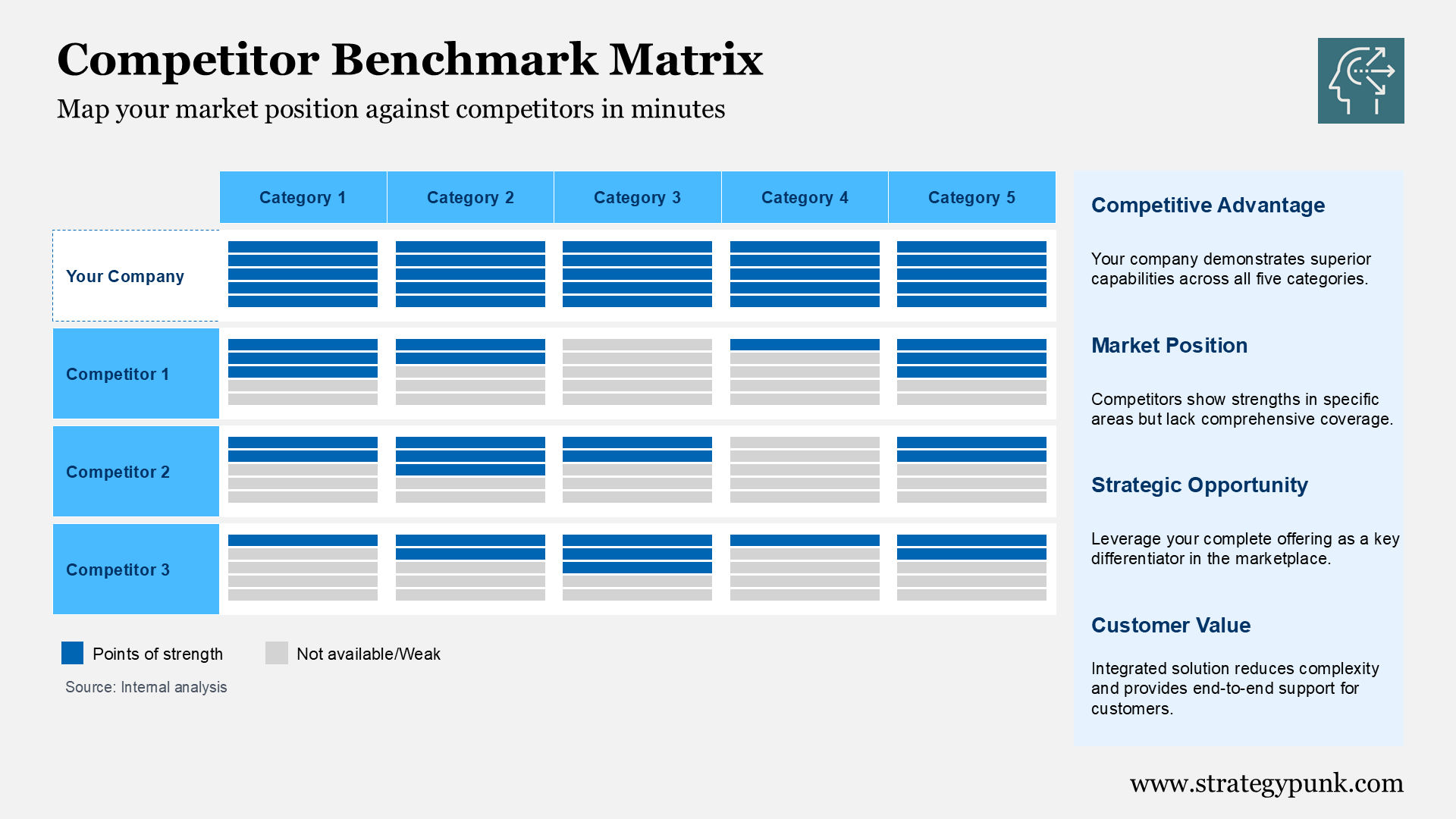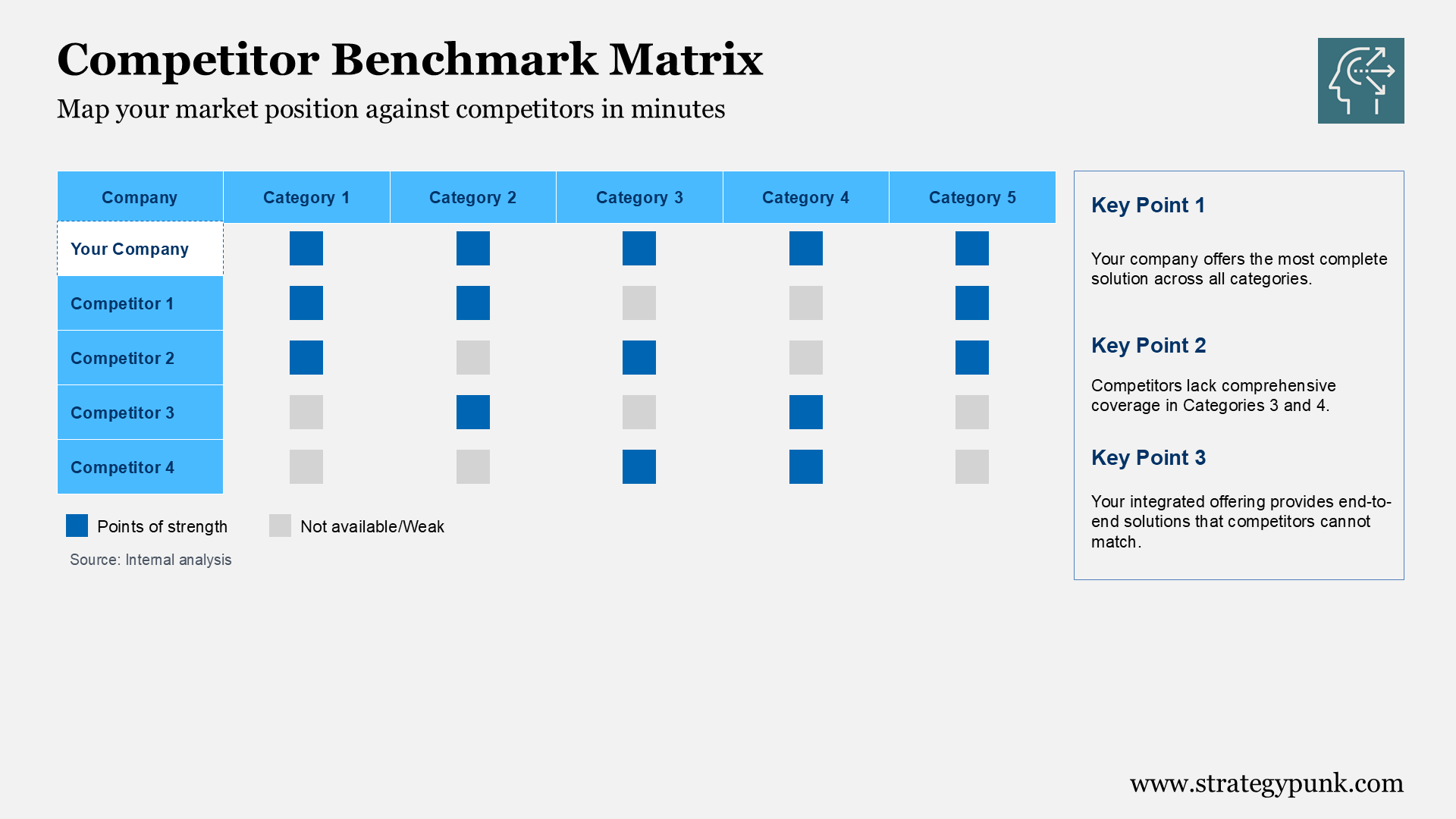The Five-Pillar Competitor Benchmark Matrix Template
Map your competitive position with the Five-Pillar Matrix. Free template reveals gaps, strengths, and opportunities in minutes.

Map your market position against competitors in minutes
Most companies struggle to understand where they stand against competitors. They collect data but lack a clear framework to visualize their competitive position.
The Five-Pillar Competitive Matrix solves this problem. This framework maps your capabilities against competitors across five core business categories, revealing gaps and strengths that drive strategic decisions.
Why traditional competitive analysis fails
Standard competitive analysis produces lengthy reports that executives never read. Teams spend weeks gathering data but struggle to extract actionable insights. The analysis sits in PowerPoint decks while competitors move ahead.
Three problems plague most competitive assessments:
- Too much data, not enough clarity
- No standard comparison framework
- Analysis disconnected from strategy
Introduction Competitor Capabilities Matrix Template
The template provides a structured approach to competitor benchmarking. This framework allows for objective evaluation of key capabilities across companiesand critical business categories.
Analysis focuses on five defined categories. Performance within each is mapped across your company and key competitors. Evaluation uses a binary assessment: "Points of strength" or "Not available/Weak".
This process yields actionable strategic insights.
Key Outcomes:
- Competitive Advantage: Determine where your company demonstrates superior capabilities.
- Market Position: Identify where competitors exhibit strengths versus gaps in comprehensive coverage.
- Strategic Opportunity: Leverage a complete offering as a key market differentiator. The current analysis suggests an integrated offering provides end-to-end solutions that competitors cannot match.
- Customer Value: Position an integrated solution that reduces complexity and provides end-to-end support for customers.
Use the Competitive Capabilities Matrix to drive strategic planning and inform resource allocation.
How the Five-Pillar Competitor Matrix works

The framework evaluates companies across five categories that matter most to your business. You define these categories based on your industry and competitive landscape.
Rate each company's strength in each category:
- Strong capability (green)
- Weak or unavailable capability (red)
The visual matrix reveals patterns immediately. You see where competitors cluster, where gaps exist, and where your company stands.
Building your matrix
Step 1: Define your five categories Choose categories that drive competitive advantage in your market. Examples include product features, market reach, technology platform, customer service, or pricing model.
Step 2: List your competitors Include 3-4 direct competitors. Add your company to benchmark your position.
Step 3: Assess capabilities Rate each company's strength in each category. Use public information, customer feedback, and market intelligence.
Step 4: Identify patterns Look for white spaces where no competitor shows strength. Find areas where you stand alone or cluster with others.
Reading the results
The completed matrix reveals four strategic insights:
Comprehensive leaders show green across most categories. These competitors pose the greatest threat and deserve focused attention.
Niche players excel in 1-2 categories but show gaps elsewhere. They may expand into your space or remain specialized.
Weak performers show mostly red. They face strategic challenges but may have hidden strengths or resources.
Your position becomes clear relative to all competitors. You see where you lead, where you lag, and where opportunities exist.
Strategic applications
Use the matrix for multiple business decisions:
Product roadmap planning: Prioritize development in categories where competitors show weakness.
Sales positioning: Emphasize categories where you show unique strength.
Partnership strategy: Find partners that complement your weak categories.
Market entry: Identify segments where no competitor shows comprehensive strength.
Investment priorities: Focus resources on categories that create competitive separation.
Implementation guidelines
Update the matrix quarterly as competitive landscapes shift. New players enter markets, existing competitors evolve, and customer priorities change.
Keep categories consistent over time to track competitive movement. Adjust only when fundamental market dynamics shift.
Share results across teams. Sales needs competitive intelligence. Product teams need gap analysis. Leadership needs strategic context.
Framework template
The template includes:
- Pre-built matrix structure
- Category definition worksheet
- Competitor research checklist
- Strategic insights summary
- Quarterly update tracker
Layout 1 Features:
- Traditional horizontal comparison matrix
- Square indicator boxes for strength points
- Company names on the left side
- Categories as column headers
- Key points section on the right side
- Dashed border highlighting your company
Layout 2 Features:
- Alternative horizontal comparison matrix
- Bar-style indicators for strength points (5 bars per category)
- More detailed visual representation of strengths
- Enhanced key points section with four strategic areas
- Dashed border highlighting your company
Download the Free Competitor Benchmark Matrix Template
Download the framework and adapt categories to your market. The structure works across industries while allowing customization for specific competitive dynamics.
Most competitive analysis creates confusion. The Five-Pillar Matrix creates clarity. Use it to see your competitive landscape clearly and act with confidence.





